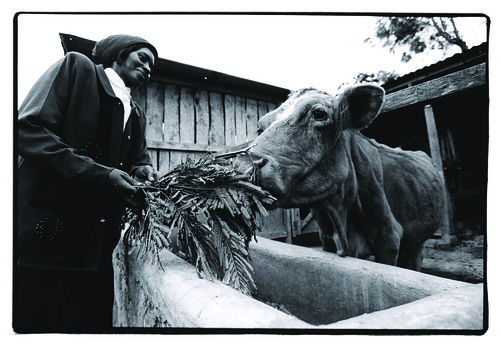‘Neglected diseases are diseases of neglected peoples’—Eric Fèvre
Animals and people live close together throughout the developing world. Chickens, goats, pigs, cows and other farmed animals range freely in and out of rural homesteads as families go about their daily lives. This space-sharing by people and their livestock makes good use of the small plots of land managed by the world’s many smallholder farmers; food that might otherwise go to waste can be fed to the animals, for example, while animal manure feeds the cropland by fertilizing it. Most of the world’s smallholder farmers depend on their animals for milk, meat and eggs to feed their families, with the surplus generating much-needed regular household income.
However, such close proximity to their animals puts many people at risk of ‘zoonotic’ diseases, which are those transmitted between people and animals. Remarkably, more than 60% of all human diseases are infections they can get from animals and more than 70% of today’s emerging diseases, such as bird flu, are zoonotic.
Because human and animal health are particularly intertwined in poor countries where people and livestock live in such close proximity, efforts to improve human health in the developing world need to focus on improving animal as well as human health. This makes it necessary for medical and veterinary experts to collaborate and for livestock farmers and herders to be made aware of the disease risks their animals pose to the health of their households.
A project begun in 2009 and funded by the Wellcome Trust, with other support from the International Livestock Research Institute (ILRI), is studying neglected zoonotic diseases and their epidemiology to raise levels of health in poor rural communities. The project, People, Animals and Their Zoonoses, is based in Kenya’s Busia District, which sits on the country’s western border, with Uganda.
Eric Fèvre, who is working jointly for the International Livestock Research Institute (ILRI) and the University of Edinburgh, is the project’s principal investigator and leader. Fèvre says this study is important.
‘Zoonotic diseases are a great burden on poor communities’, Fèvre says. ‘In a poor household where animals and people are in regular close contact, there is a significant chance of zoonotic diseases spreading. Typically in such areas, animals have access to human waste, there is little preventative health services for livestock and there is poor-quality food and forage for people and animals.’
With insufficient and/or unreliable health infrastructure and with many poor people not readily seeking professional medical attention, these diseases often go underreported or misdiagnosed. Complicating and aggravating this already serious health situation, he says, is that ‘in some cases, other non-zoonotic infections may already be present.’
Furthermore, as reported in the May 2010 issue of Veterinary Record, Fèvre says:
‘While malaria is undoubtedly a very serious health issue, its overdiagnosis hides many other problems. To compound this, people in marginalised communities can easily fall off the policy radar – many may be born, live and die without official record being made of them and, as such, they have a weak, or nonexistent, political voice. Thus, while the diseases are grouped as “neglected zoonotic diseases,” it would be equally correct to identify them as “diseases of neglected populations”.’
The Kenya zoonotic study is a four-year project that brings together ILRI scientists in Kenya with researchers from the School of Biological Sciences at the University of Edinburgh and from the Kenya Medical Research Institute, the latter of whom are already working in much of Kenya’s Western and Nyanza provinces. These epidemiologists, veterinarians, medical health professionals and laboratory technologists will visit over 500 homesteads in Busia to collect data and samples from people and livestock; those people found ill will be treated or referred to specialists.
The project data will be used to quantify the place of zoonoses in the context of other infectious diseases and to refine our understanding of factors that put people and livestock at risk. The study team also aims to come up with diagnostic tests that can be used in the field and to design cheap, easy-to-implement health interventions for both people and livestock. The project is focusing on bovine tuberculosis, cysticercosis, brucellosis, Q-fever, Rift Valley fever and trypanosomiasis (in cattle) /sleeping sickness (in people) and their impacts on both livestock and the people.
The results of this project are expected not only to improve the health aspects of the relationship between people and their livestock in western Kenya but also to provide important background for future research and policymaking on zoonotic issues.
More information can be found at www.zoonotic-diseases.org
The May 2010 issue of the Veterinary Record gives an excellent account of this ambitious human-animal health project: http://veterinaryrecord.bvapublications.com/misc/about.dtl (subscription required).


I happened to work with the project as an attache e and it was a nice experience. Thanks soo much.
Would love to discuss with the team my current research regarding peri-urban zoonoses in Kisumu, Kenya. Please contact me and we can figure out where we may be able to share information or support each other’s efforts in the region surrounding this critical issue.